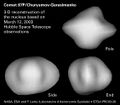Astronomy:2014 LY21
| Discovery[1] | |
|---|---|
| Discovered by | Mount Lemmon Srvy. |
| Discovery date | 2 June 2014 |
| Designations | |
| 2014 LY21 | |
| Minor planet category | |
| Orbital characteristics[2] | |
| Epoch 2 June 2014 (JD 2456810.5) | |
| Uncertainty parameter 9[2] | |
| Observation arc | ~1 hour[3][lower-alpha 1] |
| |{{{apsis}}}|helion}} | 1.0306 astronomical unit|AU (154.18 Gm) (Q) |
| |{{{apsis}}}|helion}} | 0.35603 AU (53.261 Gm) (q) |
| 0.69330 AU (103.716 Gm) (a) | |
| Eccentricity | 0.48647 (e) |
| Orbital period | 0.58 yr (210.9 d) |
| Mean anomaly | 203.00° (M) |
| Mean motion | 1.7074°/day (n) |
| Inclination | 0.80341° (i) |
| Longitude of ascending node | 73.788° (Ω) |
| 348.77° (ω) | |
| Earth MOID | 0.000140028 AU (20,947.9 km) |
| Jupiter MOID | 4.29318 AU (642.251 Gm) |
| Physical characteristics | |
| Dimensions | 4–8 m (13–26 ft)[4] |
| Absolute magnitude (H) | 29.1[2] |
2014 LY21 is a near-Earth asteroid of the Aten group, approximately 4–8 meters (13–26 feet) in diameter. On 3 June 2014 around 17:38 UT (± 3 hours), it is crudely estimated to have passed about 0.00013 astronomical unit|AU (19,000 km) from Earth.[2][lower-alpha 2] The asteroid was discovered on 2 June 2014 by the Mount Lemmon Survey at an apparent magnitude of 21 using a 1.5-meter (59 in) reflecting telescope.[1]
Uncertainty
With an observation arc of about 1 hour,[lower-alpha 1] the trajectory is poorly constrained and the asteroid has an uncertainty parameter of 9 making long-term predictions of the asteroids position nearly impossible. The nominal (best fit) orbit shows that 2014 LY21 passed 0.00013 AU (19,000 km; 12,000 mi)[2] from Earth on 3 June 2014 (~12,700 km from Earth's surface).[5][lower-alpha 2] But the uncertainty region shows that the asteroid could have approached Earth as close as 0.00006 AU (9,000 km; 5,600 mi) or as far as 0.0005 AU (75,000 km; 46,000 mi).[2] Since Earth has a radius of approximately 6,400 km, the asteroid did not come any closer than about 2,600 km from Earth's surface.
Moon
The nominal orbit shows that 2014 LY21 passed 0.001 AU (150,000 km; 93,000 mi) from the Moon on 4 June 2014.[2] But the uncertainty region shows that the asteroid could have impacted the Moon or passed as far as 0.007 AU (1,000,000 km; 650,000 mi).[2] But it is very unlikely that the asteroid impacted the Moon.
See also
Notes
References
- ↑ 1.0 1.1 "MPEC 2014-L48 : 2014 LY21". IAU Minor Planet Center. 2014-06-09. http://www.minorplanetcenter.net/mpec/K14/K14L48.html. Retrieved 2014-06-09. (K14L21Y)
- ↑ 2.0 2.1 2.2 2.3 2.4 2.5 2.6 2.7 2.8 "JPL Small-Body Database Browser: (2014 LY21)". http://ssd.jpl.nasa.gov/sbdb.cgi?sstr=2014LY21;cad=1. Retrieved 4 April 2016.
- ↑ 3.0 3.1 "2014 LY21". Minor Planet Center. http://www.minorplanetcenter.net/db_search/show_object?object_id=2014+LY21. Retrieved 2020-08-19.
- ↑ "Absolute Magnitude (H)". NASA/JPL. http://neo.jpl.nasa.gov/glossary/h.html. Retrieved 2014-06-09.
- ↑ "about 8,000 km above Earth's surface". Twitter: Ron Baalke. 2014-06-09. https://twitter.com/RonBaalke/status/476092847616049153. Retrieved 2014-06-09.
External links
- 2014 LY21 at NeoDyS-2, Near Earth Objects—Dynamic Site
- Ephemeris · Obs prediction · Orbital info · MOID · Proper elements · Obs info · Close · Physical info · NEOCC
- 2014 LY21 at ESA–space situational awareness
- 2014 LY21 at the JPL Small-Body Database
 |




